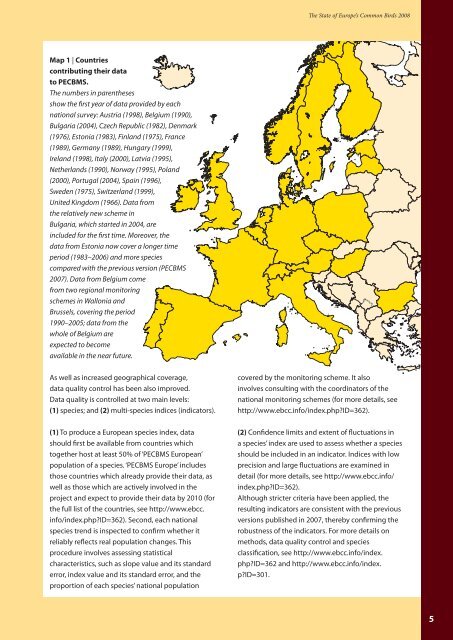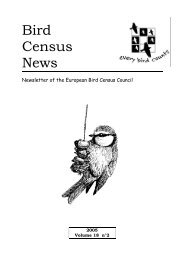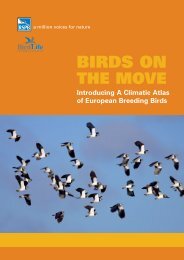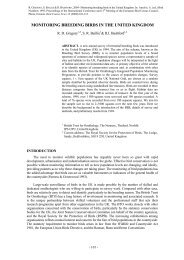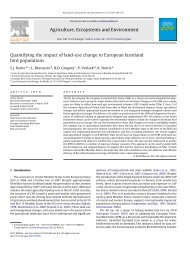The State of Europe's Common Birds 2008 - European Bird Census ...
The State of Europe's Common Birds 2008 - European Bird Census ...
The State of Europe's Common Birds 2008 - European Bird Census ...
You also want an ePaper? Increase the reach of your titles
YUMPU automatically turns print PDFs into web optimized ePapers that Google loves.
<strong>The</strong> <strong>State</strong> <strong>of</strong> Europe’s <strong>Common</strong> <strong><strong>Bird</strong>s</strong> <strong>2008</strong>Map 1 | Countriescontributing their datato PECBMS.<strong>The</strong> numbers in parenthesesshow the first year <strong>of</strong> data provided by eachnational survey: Austria (1998), Belgium (1990),Bulgaria (2004), Czech Republic (1982), Denmark(1976), Estonia (1983), Finland (1975), France(1989), Germany (1989), Hungary (1999),Ireland (1998), Italy (2000), Latvia (1995),Netherlands (1990), Norway (1995), Poland(2000), Portugal (2004), Spain (1996),Sweden (1975), Switzerland (1999),United Kingdom (1966). Data fromthe relatively new scheme inBulgaria, which started in 2004, areincluded for the first time. Moreover, thedata from Estonia now cover a longer timeperiod (1983–2006) and more speciescompared with the previous version (PECBMS2007). Data from Belgium comefrom two regional monitoringschemes in Wallonia andBrussels, covering the period1990–2005; data from thewhole <strong>of</strong> Belgium areexpected to becomeavailable in the near future.As well as increased geographical coverage,data quality control has been also improved.Data quality is controlled at two main levels:(1) species; and (2) multi-species indices (indicators).(1) To produce a <strong>European</strong> species index, datashould first be available from countries whichtogether host at least 50% <strong>of</strong> ‘PECBMS <strong>European</strong>’population <strong>of</strong> a species. ‘PECBMS Europe’ includesthose countries which already provide their data, aswell as those which are actively involved in theproject and expect to provide their data by 2010 (forthe full list <strong>of</strong> the countries, see http://www.ebcc.info/index.php?ID=362). Second, each nationalspecies trend is inspected to confirm whether itreliably reflects real population changes. Thisprocedure involves assessing statisticalcharacteristics, such as slope value and its standarderror, index value and its standard error, and theproportion <strong>of</strong> each species’ national populationcovered by the monitoring scheme. It alsoinvolves consulting with the coordinators <strong>of</strong> thenational monitoring schemes (for more details, seehttp://www.ebcc.info/index.php?ID=362).(2) Confidence limits and extent <strong>of</strong> fluctuations ina species’ index are used to assess whether a speciesshould be included in an indicator. Indices with lowprecision and large fluctuations are examined indetail (for more details, see http://www.ebcc.info/index.php?ID=362).Although stricter criteria have been applied, theresulting indicators are consistent with the previousversions published in 2007, thereby confirming therobustness <strong>of</strong> the indicators. For more details onmethods, data quality control and speciesclassification, see http://www.ebcc.info/index.php?ID=362 and http://www.ebcc.info/index.p?ID=301.5


